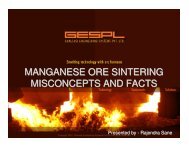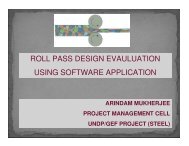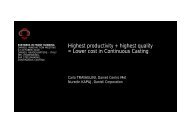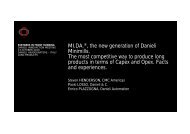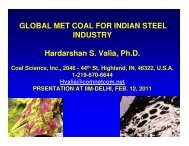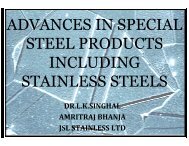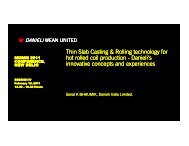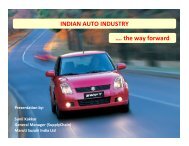New Ironmaking Processes: Relevance to India - IIM
New Ironmaking Processes: Relevance to India - IIM
New Ironmaking Processes: Relevance to India - IIM
You also want an ePaper? Increase the reach of your titles
YUMPU automatically turns print PDFs into web optimized ePapers that Google loves.
Possible Solutions: Alternatives for <strong>Ironmaking</strong>1] Production of non-liquid Iron (DRI)– Direct Reduced Iron (DRI) has emerged as anexcellent substitute for scrap for electric furnaces.– That’s why, DRI production has zoomed throughoutthe world (`~63 mt in 2010)– SL/RN, MIDREX, ITmk3 etc.2] Alternative method for Liquid Iron (Hot Metal)– Smelting Reduction (SR) processes:– COREX, FINEX, Hismelt etc.• using non-coking coal• obviating the need for coke oven batteries andsinter plants– needing smaller land/ area– Iron ore fines can be used directly (except COREX)– Lesser pollutionRDCIS3
DRI Production Technologies• DR processes have overcome many of theirsconceptual & engineering problems, andhence have been commercialized throughoutthe world in a big way.• Two major production technologies:– Coal Based Rotary Kiln process– ~20% of world DRI production– SL / RN Process, Jindal Process, TDR etc.• Gas Based Shaft Reduction processes– ~80% of world DRI production– MIDREX (~60% among all DRI processes),RDCIS4
DRI Technologies Both gas-based & coal-based DRI technology readilyavailable Scale of operation Gas based : 0.8 – 1.2 mtpa/module Coal based : 0.03 – 0.15 mtpa/module Feed s<strong>to</strong>ck : Gas based processes• Pellet (8-15mm): 33 – 100 %; Iron ore (6-30mm): 0 – 67%• Natural gas / Coal gas (not practiced yet) Coal Based <strong>Processes</strong> (rotary kiln)• Iron Ore ( 10- 20 mm): 100%,• Non-coking Coal•Any of these can be adopted based on techno-economics•<strong>India</strong> : World Leader: ~ 20 mtpy: 1/3 rd of world production• <strong>India</strong>: Pollution specially rotary Kiln processesRDCIS5
<strong>New</strong> Scheme: Coal Gasification based DRIExample: Angul Plant (6/12mt) of JSPL at Orissa• The DRI-BF-EAF route technology would be adopted forsteel production.• The DRI plant (2mt) has a unique feature of using Syn Gasfrom the coal gasification plant as reductant.• The DRI-Gasification route: first time in the world: usinghigh ash coal.• JSPL in agreement with Lurgi Sasol Technology Company,South Africa, for coal gasification technology.Blast Furnace and DRI can co-exist !Cricket: Test, ODI and T-20RDCIS6
ITmk3 Process: Production of Iron nuggets• Disadvantage in DRI: gangue remains within it• Kobe Steel, Japan: ITmk3• Ore + coal composite pellets: Reduction & melting at 1500C in RHF• It produces almost low sulphur pure iron nuggets (& slag globules)• 0.25 mtpy plant at Minnesota, USA7RDCIS7
SMELTING REDUCTIONPROCESSESforIRONMAKINGRDCIS8
Advantage: Smelting Reduction <strong>Processes</strong> They produce hot metal; hence more relevant<strong>to</strong> BOF based Integrated Steel Plants Direct use of non-coking coal and Iron ore fines They need much less land as compared <strong>to</strong>conventional BF complexRDCIS9
Available Smelting Reduction (SR) <strong>Processes</strong> 4 SR Technologies currently commerciallyexploited or ready for commercial exploitation COREX (Two stage): Operating commercially FINEX (Two stage): Operating commercially HISMELT (Single stage): Not being Operatingcommercially at presentROMELT (Single stage): Not being Operating commercially atpresent• Single stage: Reduction & melting in the same vessel• Two stage : Reduction in one vessel; melting in the 2 nd vesselRDCIS10
COREX Processfor<strong>Ironmaking</strong>RDCIS11
A schematic diagram of COREX processRDCIS12
COREX: Process Features Developed by Siemens VAI Commercially most successful amnongst SRTechnologies Commercial units in operation Korea: POSCO (COREX C-2000 – Capacity: 0.8 Mtpa) <strong>India</strong>: JSW Steel, <strong>India</strong> (2 Units) (COREX C-2000) South Africa: Mittal-SALDANHA, (COREX C-2000) China: Baosteel, (COREX C-3000) – Capacity 1.5 mtpaRDCIS13
Experience of COREX at JSW Total fuel rate requirement = 950 kg/thm. Out ofwhich ~200 kg coke is required. All the non-coking coal is imported. NCC of very highVM or very low FC cannot be used. ~ 100% pellets are charged. Oxygen requirement = 550 Nm3/thm (very high!) Corex HM ~ BF HM: Typical HM Composition: C~ 4%, Si=0.5-0.9%, S=0.025-0.07%, P=0.13-0.19%, temp= 1480-1515CRDCIS14
COREX: Process LimitationsCan't use ore fines directlyRestriction on non-coking coal VM of carbonaceous material <strong>to</strong> be maintainedat ~25% (blending of coal and coke.Net export gas (1650 nm3/thm; CV:1800 Kcal/Nm 3 ) <strong>to</strong>be utilised very economically, the process becomesun-viable. Hence, gas is used for production of DRI in MIDREX shaft(SALDANHA) and Power Generation (POSCO, JSW Steeland Bao Steel)RDCIS15
FINEX Processfor<strong>Ironmaking</strong>RDCIS16
FINEX Process Flow Sheet: Jointly developed by VAI and researchInstitute of Industrial Science & Technology, KoreaFine OreNon-coking CoalR4R3Hot DRICompactionCoalBriquettingR2Fluidized BedReductionR1CO 2RemovalPower PlantMelterGasifierProcessOptimizationOxygen PlantRDCIS17
FINEX Process Flow SheetFine OreNon-coking CoalR4Hot DRICompactionCoalBriquettingR3MelterGasifierFluidized BedReductionR2R1CO 2RemovalPower PlantProcessOptimizationOxygen PlantRDCIS18
F i n e O r eFINEX: Process FeaturesN o n - c o k i n g C o a lR 4H o t D R IC o m p a c t i o nC o a lB r i q u e t t i n gR 3R 2F l u i d i z e d B e dR e d u c t i o nR 1C O 2R e m o v a lP o w e r P l a n tO x y g e n P l a n tP r o c e s sO p t i m i z a t i o n Off-shoot of COREX Process:<strong>to</strong> use iron ore fines (-8 mm)directly Direct use of non-coking coal (-6 mm) VM of carbonaceous material <strong>to</strong> be maintained at ~25% by properblending of coal and use of coke Fine ore is pre-heated and reduced <strong>to</strong> DRI in a four stage fluidised bedsystem. R4 & R3 for preheating. In R2, fine ore is reduced <strong>to</strong> 30%. InR1, final reduction <strong>to</strong> 90%. Operational pressure: 4-5 bar. The DRI : melted in the COREX like melter- gasifierRDCIS19
FINEX: Process Features FINEX HM ~ BF HM [C= 4.5%, S = 0.03%, Si = 0.60% , Temp= 1520C Export gas (CV~2000 Kcal/Nm 3 ) can be utilised forproduction of DRI or generation of power Coal consumption @ 720 kg/t HM achieved: Pulverised coal injection @ 150 Kg./t HM.It is claimed by Finex Technology that Capitalcost is lower by 20% and production cost is15% lower as compared <strong>to</strong> BF process.RDCIS20
Limitations of FINEX Process Commercial unit of 1.5 Mtpa at Pohang, Korea –commissioned in 2007 and in operation since then. No other unit so far POSCO not interested in selling the technologyRecent GoI approval for POSCO plant in Orissa:FINEX being considered !RDCIS21
HISMELT Processfor<strong>Ironmaking</strong>RDCIS22
Smelting Reduction Vessel of HIsmeltOff-gasOxygen-enrichedhot air blastOre andcoal fines:InjectionlancesFore hearthSlag notchHMRDCIS23
HISMELT: Features Developed by Hismelt Corporation, Australia 1-Stage hot air based Smelting Reduction Process using metal bath asprimary reaction medium which is unique: Bulk of smelting of ore takes place via dissolved carbon resulting inhigh reaction rate Direct utilisation of ore fines (-0.6 mm) and non-coking coal fines (-0.3mm): feed martial is directly injected thru water cooled lances in<strong>to</strong>metal bath. No oxygen requirement – only preheated air is used Variety of coals containing 10 <strong>to</strong> 38 %VM can be used, Low coal rate(600-620 kg/thm) HM: Low P (0.02-0.05% based on ore of 0.12% P) and very very low Si Off-gas not rich (CV ~700 Kcal/Nm 3 ) – no need <strong>to</strong> generate value fromoff gasRDCIS24
HISMELT: Present StatusFirst industrial HIsmelt Plant (capacity 600,000 tpa)commenced operation in Kwinana, Australia in 2005.The plant is under maintenance as per their press-release.No other plant in the worldCurrently, there are two other licencees in China who havesigned a HIsmelt Process Licence. Under the agreements,the groups can replicate the 800,000 <strong>to</strong>nne per year HIsmeltPlant.Process seems <strong>to</strong> be suitable under <strong>India</strong>n conditions,specially for Flat product plant producing API X70/80products needing low P steel.RDCIS25
ROMELT Processfor<strong>Ironmaking</strong>RDCIS26
Schematic Flowsheet of Romelt ProcessOre FinesStream TurbineCoal & FluxWasteHeatBoilerActive BathSlagMetalOxygenRomelt SmelterPig IronRDCIS27
ROMELT: Process FeaturesDeveloped by Moscow Institute of Steel and Alloys (MISAin mid 1980s)Process operates under a slight negative pressure(1-5 mm WC)Greater raw material flexibility Accepts iron ore, slimes and other iron bearingmaterials in a wide range of sizes (0 – 20 mm)without any pre-treatment Non-coking coals of size 0 – 20 mm with moisturecontent < 10% are acceptable. High VM non-cokingcoals can be used without any preparationRDCIS28
ROMELT: Process FeaturesContd..Small scale production of 200,000 <strong>to</strong> 1,000,000 tpa HMExcellent quality of hot metal (C ~4%, Si ~0.6%, S~0.040%, Temp. ~1400 0 C). Approx. 40% of input Pgoes <strong>to</strong> slag phase & 90% of input S goes <strong>to</strong> gas phase High coal (1.3 – 1.5 t / thm) and high oxygen (900-1100– Nm 3 /thm) consumptionFairly high degree of combustion. It produces rich offgas (CV ~1000 Kcal/Nm 3 ) – has <strong>to</strong> be utilised efficiently(e.g. power generation <strong>to</strong> meet the demand of oxygenplant) <strong>to</strong> make economic production of hot metal.No commercial plant anywhere in the worldRDCIS29
Comparison of Commercially exploited/Potential SR <strong>Processes</strong>Level ofdevelopmentAbility <strong>to</strong> useore finesReductantOxygen (Nm 3 /thm) /HM QualityViabilitydependent onuse of off-gases?COREX FINEX HISMELTFully CommerciallyOne 1.5 mtpycommercialplant in operationsince 2007No Yes YesNon-coking coal(VM ~ 25 %)(<strong>to</strong> be imported)Non-coking coal(VM ~ 25%)(<strong>to</strong> be imported)~ 550 (High !) ~ 550 (High !) ~ 300One 0.8 mtpy plant wasin operation in 2005,but not nowNon-coking coal fines(-0.3mm)(<strong>to</strong> be imported)Comparable with Comparable with BF Very low P & SiBFYes Yes NoEase ofobtaining thetechnologyCommerciallyavailableUncertainAvailableRDCIS30
Conclusions: Selection of SR <strong>Processes</strong> under <strong>India</strong>n Conditions Out of 3 potential SR processes, only COREX is commerciallyexploited till date. FINEX is on the verge of commercialisation. COREX & FINEX processes: sensitive <strong>to</strong> quality of input materialparticularly w.r.t. VM and ash of coal. Type of coal required for theseprocesses is scarcely available in <strong>India</strong>. Experience of COREX at JSW suggest that still ~ 15% coke isrequired in the process <strong>to</strong> control VM of the input reductant. Samemay be the case for FINEX process. Use of pellet atleast partially is a must for COREX process. For FINEX& HISMELT process, iron ore fines can be directly used. For COREX & FINEX processes, large amount of oxygen is required. For COREX & FINEX processes, rich off gas generated in the processneed <strong>to</strong> be used either for generation of power or for production ofDRI. Hismelt is suitable for steel product with low P.RDCIS31
RDCIS32
Midrex Process Flow Sheet - HBI ProductionRDCIS33
Production Technologies• Coal Based Rotary Kiln processLump ore/ pelletsCoalRotary KilnDRICharScheme for DRI Production in Rotary KilnRDCIS34
Production TechnologiesGas based ProcessLump Iron ore or PelletsReformedNatural Gas Shaft Hot HBIReac<strong>to</strong>rBriquettingPressCold DRI ProductScheme for HBI Production in Shaft Reac<strong>to</strong>rRDCIS35
Salient Features of Midrex Process• Both pellets (8-15 mm) & sized lump ore (6-30 mm)(up<strong>to</strong> 50% can be charged).• Reformed Natural Gas: CO=80%, H 2 =20%• Specially suitable for countries/ locations wherenatural gas is available in plenty and less expensive• <strong>India</strong>n Scenario:– Essar Steel, Hazira– Ispat Industries, RaigadCoal gassification based DRI plant (JSPL plant at Angul,Odisha) may open a new trend in <strong>India</strong>/ worldRDCIS36
ITmk3 COMPARE TO OTHER DIRECT REDUCTION/SMELTING PROCESSESITmk3 technology has the better economics at small scale productioncompare <strong>to</strong> other competing processesRelative cost <strong>to</strong>ITmk3 processITmk3Midrex CoalBased (DRI)Corex Rotary kiln +melterBF+CO+SPCapital cost,500,000 t/yOperating cost,500,000 t/y1 1.58 2.4 1.5 1.981 1.11 1.53 1.2 1.27Relative cost <strong>to</strong>ITmk3 processCapital cost,500,000 t/yOperating cost,500,000 t/yHIsmelt Romelt1.16* 1.11.1 1.3437RDCIS37
RELATIVE ECONOMICS OF COMMERCIAL EXPLOITED SRPROCESSES vis-à-vis MINI BLAST FURNACE (MBF)[A] Assessment of Raw Material & EnergyCOREX FINEX HISMELT ROMELT MBFIRON BEARING MATERIALS• Sized Ore Indigenous - - - Indigenous• Pellets Indigenous - - - -• Fines - Indigenous Indigenous Indigenous -REDUCTANT• Non-coking coal Imported Imported Imported Blended* -• Coke Imported Imported -* 50% <strong>India</strong>n and 50% imported-ImportedRDCIS38
RELATIVE ECONOMICS OF COMMERCIAL EXPLOITED SRPROCESSES vis-à-vis MINI BLAST FURNACE (MBF)[B] Comparison of Specific Consumption NormsCOREX FINEX HISMELT ROMELT MBFA. Hot Metal Capacity(‘000 tpa)800 800 600 300 500B. Raw Materials• Sized iron ore (t) 0.40 - - - 1.52• Iron Pellet (t) 1.20 - - - -• Iron ore fines (t) - 1.60 1.65 1.60 -• Imported coke (t) 0.16 0.16 - - 0.63• Non-coking coal (1) (t) 0.90 0.90 - 1.27 -• Non-coking coal (2) (t) - - 0.82 - -• Limes<strong>to</strong>ne (t) 0.16 0.16 - - 0.09• Dolomite (t) 0.09 0.09 - - 0.11• Calcined dolomite (t) - - 0.03 - -• Lime (t) - - 0.05 0.13 -C. Energy inputs• Oxygen (Nm 3 / t) 570 570 253 1100 -• Electric power (Kwh/t) 69 69 125 150 75• Fuel gas (Nm 3 / t) - - 27 - -(1)Based on 50% Indigenous & 50% imported coalContd..(2) Based on imported coal with 10% VM & 10% ashRDCIS39
RELATIVE ECONOMICS OF COMMERCIAL EXPLOITED SRPROCESSES vis-à-vis MINI BLAST FURNACE (MBF)Contd..[C] Relative Costs of Hot MetalProcess Capital Cost Production Cost(with power credit)COREX 80FINEX (1.5 mtpy) 80 85HISMELTROMELTBlast Furnace 100 100RDCIS40
RELATIVE ECONOMICS OF COMMERCIAL EXPLOITED SRPROCESSES vis-à-vis MINI BLAST FURNACE (MBF)[D] Comparison of Power Generating Potential from Surplus GasItem COREX FINEX HISMELT ROMELT MBFHot metal capacity,‘000 tpa800 800 600 300 500Contd..Gas generation,Gcal/thm3.7 3.7 1.03 2.4 1.6CV of gas, Kcal/thm 2000 2000 Low 1000 800Power plantcapacity, MWEnergy credit (Afterinternalconsumption),kWh/thm130 130 27 54 281161 1161 221 1210 359RDCIS41



